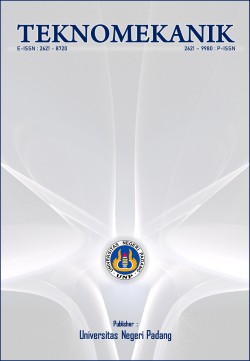Design analysis configuration and capacity of off-grid with implementation of photovoltaic (PV) and battery energy storage system (BESS) as power supply for shipping activities at ports
DOI:
https://doi.org/10.24036/jptk.v6i1.31623Keywords:
Photovoltaic (PV), Battery Energy Storage System (BESS), Off-Grid, Port, ShipAbstract
The government of Indonesia developing mitigation for climate change and achieving decarbonization in the sea transportation sector by encouraging increased use of onshore power supply for ships when berthing at ports. Off-Grid is one of the green transition technologies that provide great benefits to ports for the mitigation of environmental. To ensure optimal system operation, determining the proper configuration and component sizes is an important decision at the design stage. One of the important activities at the port is the transportation of mining products, B3 waste, and others by using ships operated with diesel engines which are known to be expensive and not environmentally friendly. The configuration consists of a photovoltaic system and an energy storage system as well as land electricity support at the port then optimized by considering solar radiation, temperature, and data component specifications to supply power to the ship so that do not use diesel generators on board. From the calculation results it is known that when the ship is anchored it requires 3,310.34 kWh/day of electrical energy. To meet electricity needs, 3,200 units of PV modules are designed with a power output of 1,216 kW peak and a BESS capacity of 4,064 kWh.
Downloads
References
Al Riza, D. F., & Gilani, S. I. U. H. (2014). Standalone photovoltaic system sizing using peak sun hour method and evaluation by TRNSYS simulation. International Journal of Renewable Energy Research, 4(1), 109–114.
Badan Pusat Statistik. (2022). Statistik Indonesia. In Badan Pusat Statistik (Vol. 1101001). https://www.bps.go.id/publication/2020/04/29/e9011b3155d45d70823c141f/statistik-indonesia-2020.html
Bhatia, A. (2018). Design and Sizing of Solar Photovoltaic Systems. Continuing Education and Development, Inc, 877, 2–125.
Boksman Asia. (2022). Kapal Listrik Baterai untuk Ekspedisi Kontainer, Kurangi Emisi Karbon. Boksman.Com. https://boksman.com/blog/ekspedisi-kontainer-dengan-kapal-listrik-baterai-kurangi-emisi-karbon
Energising development. (2018). Instalasi Pembangkit Listrik tenaga Surya Dos & Don’ts ( ing. B. Ramadhani (ed.)). Deutsche Gesellschaft für Internationale Zusammenarbeit (GIZ) GmbH Energising Development (EnDev) Indonesia.
Gumintang, M., Sofyan, M., & Sulaeman, I. (2020). Design and Control of PV Hybrid System in Practice. In Deutsche Gesellschaft für Internationale Zusammenarbeit (GIZ). Deutsche Gesellschaft für Internationale Zusammenarbeit (GIZ) GmbH, atas nama Kementerian Federal Jerman untuk Kerja sama Ekonomi dan Pembangunan. www.giz.de
Huawei. (2022). Fision Solar Smart Micro-grid Solution. Solar Huawei, 1–39. Solar.huawei.com
IESR. (2021). Climate Transparency Report. In IESR. https://iesr.or.id/en/pustaka/climate-transparency-report-2021
Jufri, F. H., Sudiarto, B., & Garniwa, I. (2021). Optimal Hybrid Renewable Energy System Design for Generation Cost Reduction and Increased Electrification in Isolated Grid in Indonesia. 2021 IEEE 4th International Conference on Power and Energy Applications, ICPEA 2021, 147–152. https://doi.org/10.1109/ICPEA52760.2021.9639295
Kemenhub. (2022). Surat Edaran Nomor SE-DJPL 22 Tahun 2022 Tentang Penggunaan Fasilitas Listrik Darat (Onshore Power Supply (OPS)) di Pelabuhan bagi Kapal yang Berlayar di Perairan Indonesia.
Kim, D. K., Yoneoka, S., Banatwala, A. Z., Kim, Y.-T., & Nam, K.-Y. (2018). Handbook on Battery Energy Storage System. In Asian Development Bank (Issue December). https://www.adb.org/publications/battery-energy-storage-system-handbook
KLHK. (2020). Laporan Inventarisasi GRK 2020 dan Monitoring, Pelaporan, Verifikasi (MPV). In Kementerian Lingkungan Hidup dan Kehutanan.
Latasya, Z., Sara, I. D., & Syahrizal, S. (2019). Analisis Rancangan Pembangkit Listrik Tenaga Surya (Plts) Off-Grid Terpusat Dusun Ketubong Tunong Kecamatan Seunagan Timur Kabupaten Nagan Raya. Jurnal Komputer, Informasi Teknologi, Dan Elektro, 4(2), 1–14. http://www.jurnal.unsyiah.ac.id/kitektro/article/view/12951
Oladeji, A. S., & Akorede, M. F. (2019). Assessment of Solar and Hydropower Energy Potentials of Three Rural Communities in Nigeria. IEEE PES/IAS PowerAfrica Conference: Power Economics and Energy Innovation in Africa, PowerAfrica 2019, 187–192. https://doi.org/10.1109/PowerAfrica.2019.8928929
Outlook Energi, B. (2021). OUTLOOK ENERGI INDONESIA 2021 Perspektif Teknologi Energi Indonesia: Tenaga Surya untuk Penyediaan Energi Charging Station. In Pusat Pengkajian Industri Proses dan Energi (PPIPE) Badan Pengkajian dan Penerapan Teknologi (BPPT).
Pemerintah Indonesia. (2014). Peraturan Pemerintah Republik Indonesia Nomor 79 Tahun 2014 Tentang Kebijakan Energi Nasional.
Peraturan Presiden. (2017). Peraturan Presiden Republik Indonesia Nomor 22 Tahun 2017 tentang Rencana Umum Energi Nasional.
Peraturan Presiden. (2021). Peraturan Presiden Republik Indonesia Nomor 98 Tahun 2021 Tentang Penyelenggaraan Nilai Ekonomi Karbon untuk Pencapaian Target Konstribusi yang ditetapkan Secara Nasional dan Pengendalian Emisi Gas Rumah Kaca dalam Pembangunan Nasional.
Sky Energy. (2018). Smart Power Live Better Our Product Catalogue. Dutch Lady Milk Industries Bhd.
Downloads
Published
Issue
Section
License
Copyright (c) 2023 Fiqi Mutiah, Budi Sudiarto

This work is licensed under a Creative Commons Attribution 4.0 International License.





